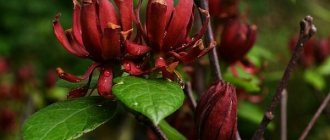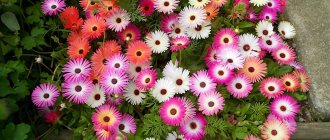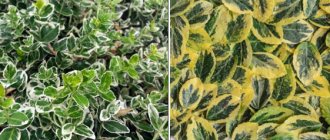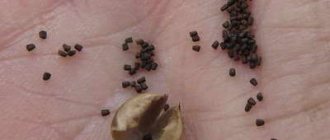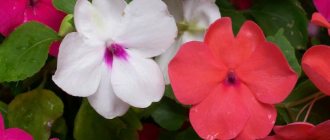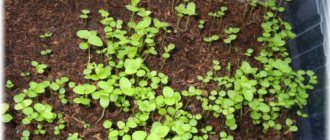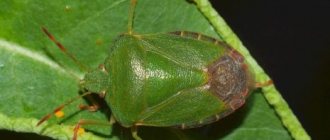Chilean gravilate is a perennial plant that belongs to the Rosaceae family. There are about 50 varieties in nature, but only about 20 species are planted. In its natural environment, the plant prefers to grow on the banks of reservoirs or on the edge of a forest. The population nicknamed this plant Benedict grass, comb grass.
Gravilat is about 70 cm in height. The leaves are like feathers, wrinkled and unsightly in appearance.
The shade is dark green. Leaves grow from the root and stem. Leaves growing from the root system are larger in size than those growing from the stem. The inflorescences have a pale yellow tint. After ripening, fruits appear in the form of nuts, pubescent on the outside. Flowering occurs in summer. [Hide]
Description
Gravilat has the shape of a bush up to 60 cm in height. Large, bright green leaves grow from the roots and have an odd-pinnate structure. The root of the plant is woody and goes deep underground.
The flowering period occurs at the end of June and lasts 1.5-2 months. The flowers grow up to 3 cm in diameter and are red, yellow or pink. The fruits of the plant are small nuts.
The plant genus includes about 50 species, of which only a third are grown. In nature, Gravilat Chilean can be found along the banks of rivers, lakes or on the edge of forests.
Kinds
Breeders count about 60 types of gravilate. In Russia, Benedict's grass is widespread in the Urals, Siberia, the Volga region, the Far East, the Caucasus and other regions. A beautiful, hardy perennial found throughout Europe.
Mountain
The most common type of gravilate. The plant is low - up to 20 centimeters. Produces flowers of bright yellow color, excellent for alpine hills, the flowering period begins in May.
Creeping
Flowers of this species decorate rocky gardens. Yellow bell-shaped inflorescences. Creeping gravilate is used to create carpets. The leaves of the plant are decorative, dissected, small, velvety.
Urban
Benedict's grass is the second name for the city's gravilate. This species is common in Europe. Forms erect stems up to 50 centimeters high. The flowering period begins in May. The flowers are yellow, 3 centimeters in diameter.
Chilean
A tall type of gravilate. The height of an adult plant reaches 60 centimeters or more. Bright red flowers will not leave anyone indifferent. Hybrid varieties are bred based on this species. The disadvantage is the short flowering period.
Hybrid
The fruits of the labor of breeders. Most often, Chilean gravilate is used as the basis for creating a new variety. All hybrids are characterized by increased frost resistance and disease resistance.
Bright red
Forms a perennial in the form of a bush. Distributed in the Caucasus. The flowers are orange-red in color with beautiful golden-yellow stamens. The flowering period begins in May and continues until the end of August.
River
An endangered species listed in the Red Book. Forms wild thickets along the banks of rivers and reservoirs. Can reach 80 centimeters in height. The flowers are very beautiful, reminiscent of a drooping double bell, of an unusual pink color with various shade transitions.
Note: It is a good honey plant and a natural insecticide..
Rossa
A plant of the rocky mountains, absolutely undemanding to soil quality and growing conditions. Forms a bush of medium branching with a height of no more than 40 centimeters. A distinctive feature of the species is its genetic frost resistance; it tolerates winters with frosts down to -36 C. The flowers are yellow, planted in groups in rocky gardens and on alpine hills.
Trifloral
The homeland of the species is North America. It grows on slopes in dense groups; the perennial reaches a height of no more than 35 centimeters. The second name is “prairie smoke” - the seed pods form long white hairs stretched upward. During windy days, the boxes sway and create the visual effect of creeping smoke.
Terry
It is distinguished by the beautiful original appearance of its inflorescences, reminiscent of terry poppies. The flowering period is long - from May to September. The species is quite frost-resistant.
See also
Preparing lavender for wintering in the Moscow region and how best to cover the plantRead
large-leaved
Herbaceous perennial up to 80 centimeters high. It produces small yellow flowers no more than 2 centimeters in diameter. Not a popular type for landscape design.
Medicinal properties
Gravilat Chilean includes:
- tannins - compounds with an astringent effect that help in the treatment of gastrointestinal pathologies and stopping bleeding;
- essential oil is a substance with a strong odor and taste that has an antibacterial and therapeutic effect;
- flavonoids – compounds similar to female sex hormones;
- alkaloids – substances that have an analgesic, anti-inflammatory effect;
- phenolcarboxylic acids - compounds that have choleretic, antibacterial and tuberculostatic (an agent for fighting tuberculosis) effects;
- vitamins and minerals.
Due to the high content of useful substances, the plant has the following medicinal properties:
- stops bleeding;
- relieves pain;
- restores tissues and cells;
- calms;
- helps the functioning of the gastrointestinal tract;
- destroys bacteria and parasites;
- strengthens the body.
Urban gravilate root has an anti-inflammatory effect, helps normalize vascular permeability, reduce swelling, due to the presence of catechins in the composition
Caring for gravilate is simple and difficult at the same time
When organizing the care of gravity plant, you need to be prepared for the fact that the crop has increased requirements for the conditions of its habitat. Depending on the type, gravilat can be frost-resistant.
They are also differentiated by their need for light: some prefer full sun, while others prefer a little shade. Some grow happily in dry conditions, but most require additional moisture. When storing in winter, there is a risk that the gravilate will begin to rot, especially if the soil or storage area is very wet.
It adapts easily to any soil, but prefers neutral to slightly acidic soils. everything here is simple and complicated at the same time, since you need to create a neutral reaction of the soil with the appropriate irrigation regime.
During flowering, it may fall off and bloom again several times during the summer. Susceptible to some pests and diseases that can harm the gravilate.
Care
Planting and care are simple - Gravilat is unpretentious and suitable for gardeners of any level. If you follow all the recommendations about the nature of the soil, light and watering, all plant care will be reduced to the timely removal of dry branches and flowers.
Planting and soil
The soil for the plant should not be oxidized or waterlogged. The shrub loves drained soil, so before planting it is recommended to add a mixture of sand, ash or charcoal to the area.
Sow seeds in spring, in prepared soil. Additionally, you can add compost to the soil.
When sowing, the distance between plants should be at least 25 cm.
Light
The shrub needs bright lighting; it does not like dark areas.
Temperature
The plant is warm and light-loving, but also tolerates frost. For regions with harsh winters, the flower still needs to be protected during cold weather - covered with leaves, straw, spruce branches.
Watering
Gravilat Chilean should be watered moderately and regularly. The plant does not tolerate overflows and long droughts. During the peak summer heat, watering can be done abundantly.
Chilean Gravilat: planting
Chilean Gravilat: photo of a plant in landscape design
It is necessary to choose the right area for transplantation so that the flower is beautiful and healthy.
Required lighting
The Chilean Gravilata needs an area well lit by the sun's rays. These flowers can live in the shade, but their growth rate will decrease.
Choosing soil for planting Chilean gravel
Chilean Gravilat: plant photo
For Chilean gravilate, non-oxidized soil is more suitable. It is necessary to treat the soil with a mixture of coarse sand, charcoal and deciduous soil before planting. The plant should not be replanted in soil that is too moist; you can add a small amount of soil under the flower bed.
Correct transplantation of Chilean gravilate
Photo of Chilean gravilate
When planting Chilean grass, you should avoid the spring period. The flower is unpretentious, but it is recommended to loosen the soil before replanting. It is necessary to fertilize the soil with humus or peat. If you plan to transplant a flower into acidic soil, it is important to add dolomite flour to it. The recommended distance between bushes is at least twenty centimeters.
Useful tips when landing
Photo of Chilean gravilate
It is recommended to use low elongated ridges. They will look good as a frame for paths. Another smart solution is mixborders. They are needed for a collection of constantly flowering plants.
A beautiful composition will be obtained when planting gravilata with other flowers.
Alternatively, gravilate can be used as a carpet lawn decoration. The bush will not bloom so often, due to the lack of sufficient lighting, but it will delight the eye with beautiful greenery.
Reproduction
Reproduction occurs in 2 ways - by seeds and by dividing the plant.
The first method is growing from seeds. They need to be planted in March-April in small containers for seedlings (boxes, glasses) to a depth of 1 cm and covered with film to maintain the desired level of humidity. After about 14 days, the seeds will germinate. After this, young plants should be regularly ventilated and watered.
Gravilat seeds
Grown seedlings are planted in open ground in late spring or early summer. Gravilat will bloom only a year after planting.
The second method is vegetative. This is the division of one plant into several. Division is carried out in spring or autumn. You need to dig up Chilean Gravilat, divide it so that each part has roots and a shoot with buds, and immediately plant it in the prepared places.
After planting, the plant needs to be watered abundantly for the first time.
Features of flowering
The plant blooms at the end of July and delights us with its double inflorescences for at least three weeks. What a pleasure it is to admire flowers during this period. They paint our areas with new colors - bright and rich.
As already mentioned, gravilat is an unpretentious plant. He favors shady areas of the garden, but at the same time is not afraid of the sun. Therefore, it can be grown almost anywhere. The only difference will make itself felt during the flowering period. If the plant is planted in the shade, then it will not bloom so magnificently and abundantly. However, this also has its advantage. The flowering period will last longer.
Diseases and pests
Gravilat Chilean can become infected with a fungal disease if the soil is not disinfected before planting. Fungicides are used to combat the fungus.
During the life cycle, the plant rarely gets sick, but in the case of constant heavy watering, root rot may appear. In this case, the plant will have to be destroyed.
Among the pests, spider mites can appear due to insufficient watering. To destroy it, you will need a medicine against ticks and the restoration of a regular watering regime.
Dividing the bush
This process is best done in the spring; it is not recommended to repeat it more than four times a year. The daughter rosettes with pieces of the root system should be carefully separated from the mother plant. Seedlings should be planted immediately and watered generously. Plant protection in winter
Chilean Gravilate has good frost resistance, but it is better to protect it by covering it from frost. As a shelter, you can use spruce branches or a thick carpet of fallen leaves. Using fabric covers is useless.
Interesting! A decoction of gravilate allows you to normalize sweating.
Chilean Gravilat is a very beautiful plant; it can decorate any garden plot. With proper care, the plant will delight you for a long time.
Use in folk medicine
Infusions and decoctions from Gravilat are used mainly to stop bleeding, treat diseases of the gastrointestinal tract and the female reproductive system.
In general, remedies from the plant have shown themselves to be effective in the treatment of inflammatory diseases - inflammation of the oral cavity (stomatitis), gums (gingivitis), kidneys (nephritis), prostate (prostatitis) and in getting rid of infection by parasites (for example, helminths).
In cooking
Since the roots of the plant contain a large amount of starch, carbohydrates, vitamins, and also have a spicy smell and taste, they are used for food.
The rhizomes are ground into powder and used as spices for meat and fish or added to alcoholic tinctures for flavor. Gravilata leaves are prepared in soups or purees.
How to sow gravilat seeds in the ground
in spring
Spring sowing begins as early as possible, as soon as the soil ripens. They loosen the bed, dug up since the fall, and level the ground with a rake. Make rows at a distance of 15-20 cm, sow the seeds shallowly, up to 2 cm, level the ground with the back of the rake.
It is advisable to predict the weather before the rain, then you won’t have to water. If the weather is dry, the bed is moistened with a watering can, but not flooded, so as not to create an earthen crust. It is better to water a little every evening than to water occasionally.
When the shoots appear, the bed is weeded to remove weeds and the gravel itself is thinned out, leaving at least 5 cm between plants. When the seedlings rise to 10-15 cm, they are transplanted to a permanent place. The distance between the bushes is 40 cm.
in autumn
The timing of sowing will depend on the region, the main thing is that after sowing there is no prolonged heat, which is why the seeds may sprout in the fall. Gravilat is usually sown before winter around October, when it is already quite cold. The bed should not be specially insulated: the seeds will not freeze, and natural stratification will benefit them, and the plants will sprout together in early spring.

